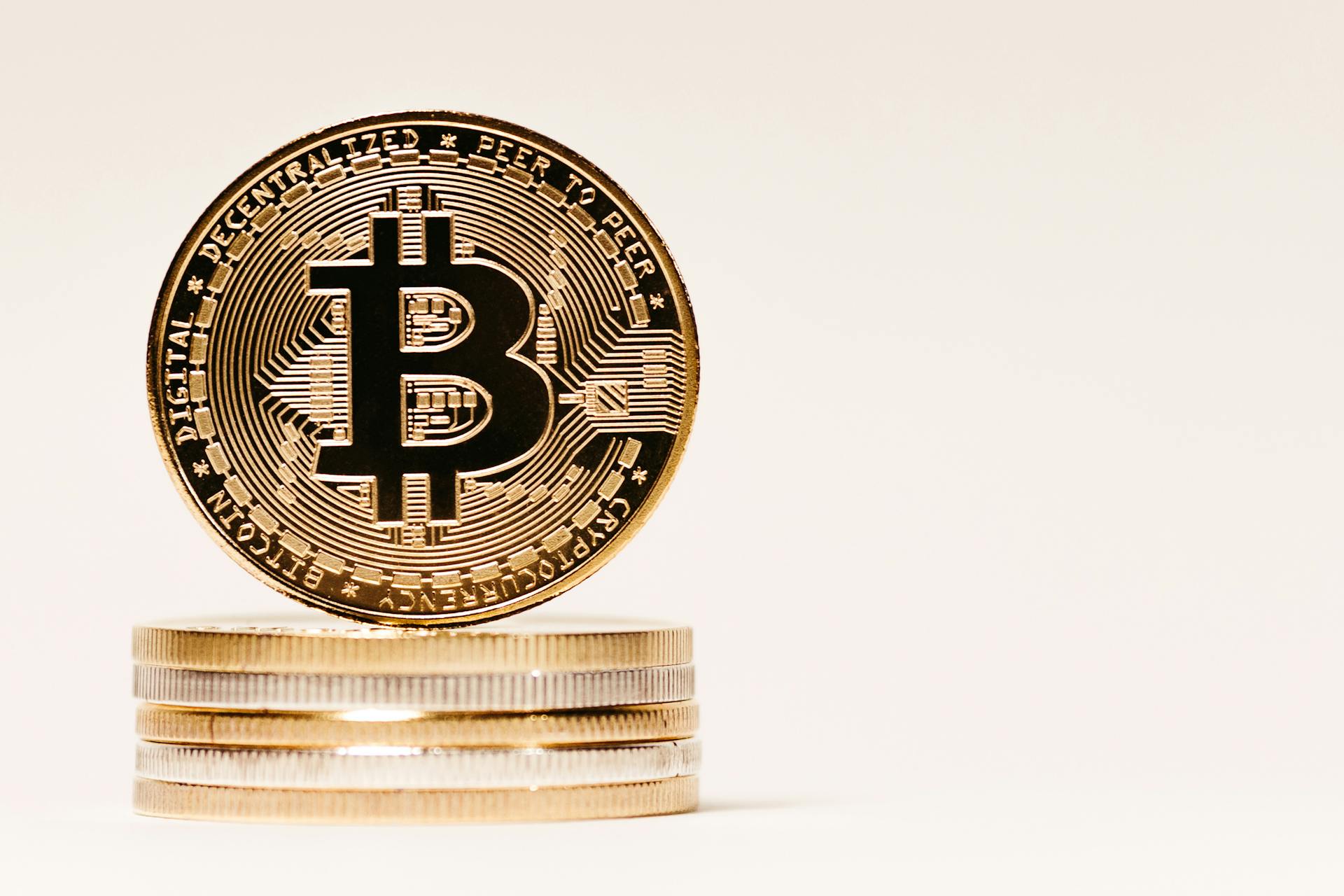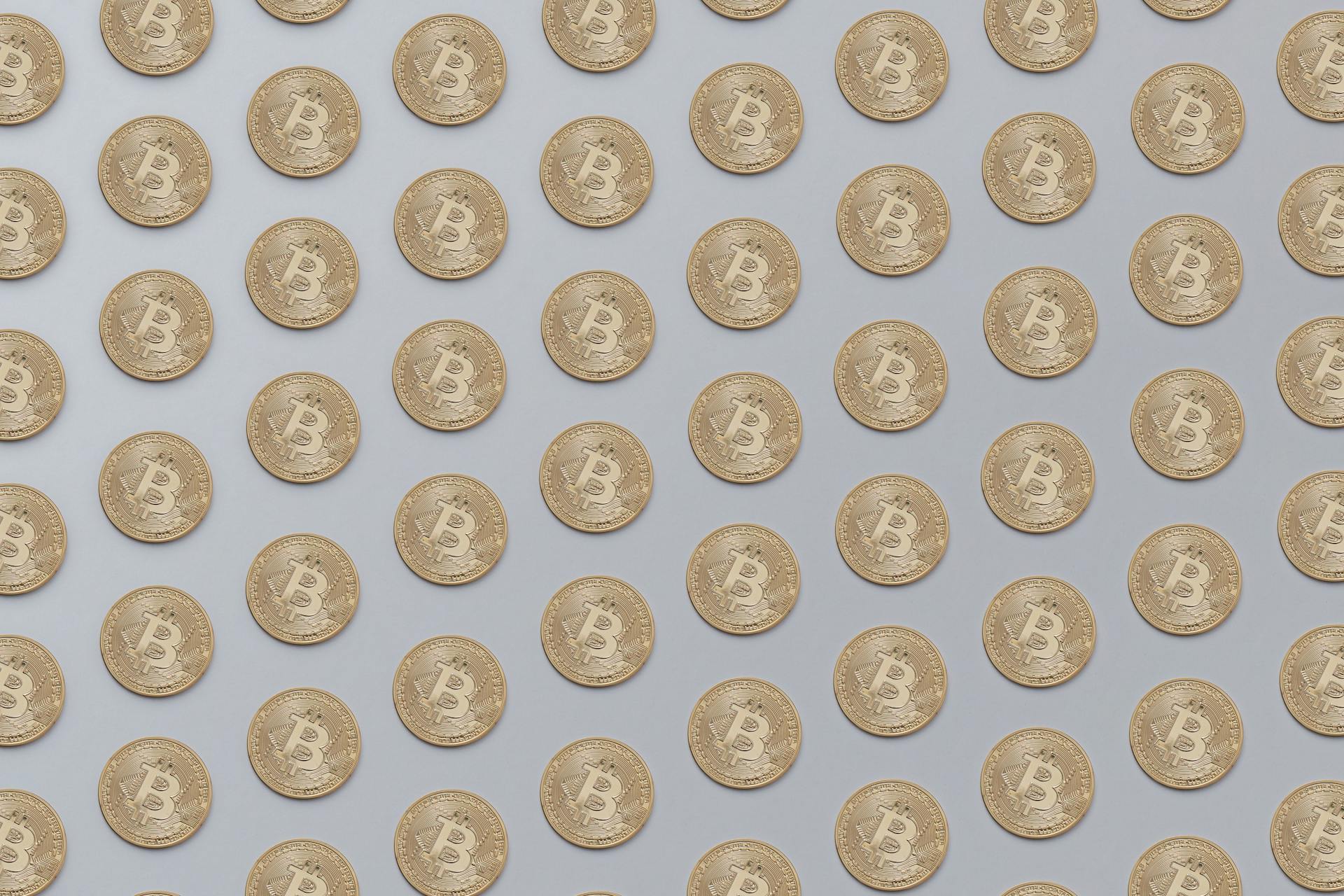
Automated Market Makers (AMMs) on Xrpl are decentralized exchanges that allow users to trade digital assets without the need for a traditional order book.
These AMMs use liquidity pools to facilitate trades, and the liquidity pools are typically funded by users who deposit their assets into the pool.
The liquidity pools are managed by smart contracts, which ensure that trades are executed fairly and efficiently.
The AMM model has gained popularity due to its simplicity and low fees, making it an attractive option for traders and investors.
On Xrpl, AMMs are built on top of the Xrpl blockchain, utilizing its decentralized and open-source nature to provide a secure and transparent trading environment.
The Xrpl blockchain's high scalability and low latency make it an ideal platform for AMMs, enabling fast and reliable trades.
Discover more: Xrpl Price
How Automated Market Maker Works
An Automated Market Maker (AMM) is a key component of the XRP Ledger's decentralized exchange, allowing for seamless trading between assets.
An AMM holds two different assets, with at most one being XRP, and one or both being tokens. Anyone can create an AMM for an asset pair if it doesn't exist, or deposit to an existing one.
For any given pair of assets, there can be up to one AMM in the ledger, ensuring a single source of liquidity for traders. A single transaction might execute by matching Offers, AMMs, or a mix of both, depending on what's cheaper.
You can determine if a Payment or OfferCreate transaction interacted with an AMM by checking for a RippleState ledger entry in the transaction metadata. A Flags value of 16777216 indicates AMM liquidity was consumed.
An AMM sets its exchange rate based on the balance of assets in the pool, adjusting the rate as its supply of one asset goes down or up.
The more a trade unbalances the AMM's supply of the two assets, the more extreme the exchange rate becomes. This is why AMMs give generally better exchange rates when they have larger overall amounts in their pool.
The XRP Ledger implements a geometric mean AMM with a weight parameter of 0.5, functioning like a constant product market maker. The AMM also charges a percentage trading fee on top of the exchange rate.
A different take: Market Exchange Rate
DEX Interaction
Automated market makers on XRPL can seamlessly interact with decentralized exchanges (DEXs) to boost liquidity. This integration combines the strengths of both systems.
AMMs are paired with DEXs to create a more efficient trading environment. This allows for automatic optimization of offers and payments to find the best rate.
The system determines whether swapping within a liquidity pool or through the order books provides the best rate. It then executes the trade accordingly.
This hybrid approach ensures that transactions use the most efficient path for trades. Whether that's through offers on the DEX or through AMM pools, or a combination of the two.
The diagram illustrating the interaction between an offer and other offers and AMM liquidity in the DEX shows how this process works.
Asset Management
To create an automated market maker (AMM) on the XRP Ledger, you need to select and acquire assets carefully, as you'll be supplying them to the AMM for users to swap between.
Choose any pair of fungible assets, including XRP or tokens, as long as they meet the restrictions on AMM assets. You can choose any pair you like, but be aware that if one asset becomes worthless, the AMM will hold only that worthless asset.
For each asset, you need to know its currency code and issuer, except for XRP which has no issuer. You must also hold a balance of the asset or be the issuer.
Acquire Assets
To create an Autonomous Market Maker (AMM), you need to select and acquire assets that will be used for trading.
You can choose any pair of fungible assets in the XRP Ledger, including XRP or tokens, as long as they meet the restrictions on AMM assets.
As the creator of an AMM, you must hold a balance of each asset, or be the issuer of one of the assets. XRP is an exception, as it has no issuer.
You'll need to know the currency code and issuer for each asset, which can be found in the XRP Ledger.
To acquire assets, you can buy or receive them from the issuer, just like in the example code that acquires "TST" and "FOO" tokens.
In a production scenario, you might acquire a second token by making an off-ledger deposit with the stablecoin issuer, or buying it in the decentralized exchange.
The helper function for issuing tokens is similar to the steps outlined in the Issue a Fungible Token tutorial, but with some abbreviations.
Restrictions on Assets
To create a successful Asset Management strategy, it's essential to understand the restrictions on assets used in an AMM (Automated Market Maker). If you try to create an AMM with an asset that doesn't meet these restrictions, the transaction fails.
The rules are as follows:
- The asset must not be an LP token from another AMM.
- If the asset is a token whose issuer uses Authorized Trust Lines, the creator of the AMM must be authorized to hold those tokens.
- If the Clawback amendment is enabled, the issuer of the token must not have enabled the ability to claw back their tokens.
Having a clear understanding of these restrictions will help you avoid any potential issues and ensure a smooth Asset Management process.
LP Tokens and Codes
Anyone can create an Automated Market Maker (AMM) and receive LP tokens that represent 100% ownership of assets in the AMM's pool.
These LP tokens can be redeemed to withdraw assets from the AMM in proportion to the amounts currently there. The proportions shift over time as people trade against the AMM.
LP tokens are like other tokens in the XRP Ledger and can be used in many types of payment or traded in the decentralized exchange. To receive LP tokens as payment, you must set up a trust line with a non-zero limit with the AMM Account as the issuer.
The AMM is designed so that an AMM's asset pool is empty if and only if the AMM has no outstanding LP tokens. This situation can only occur as the result of an AMMWithdraw transaction; when it does, the AMM is automatically deleted.
LP tokens use a special type of currency code in the 160-bit hexadecimal "non-standard" format with the first 8 bits 0x03. The remainder of the code is a SHA-512 hash, truncated to the first 152 bits, of the two assets' currency codes and their issuers.
The assets are placed in a "canonical order" with the numerically lower currency+issuer pair first, resulting in a predictable, consistent currency code for the LP tokens of a given asset pair's AMM.
Trading and Fees
Trading and Fees is a crucial aspect of Automated Market Makers (AMMs) on the XRP Ledger. Trading fees are a source of passive income for liquidity providers, offsetting the currency risk of letting others trade against the pool's assets.
Liquidity providers can vote to set the fee from 0% to 1%, in increments of 0.001%, in proportion to the number of LP tokens they hold. They have an incentive to set trading fees at an appropriate rate, as fees that are too high may cause trades to use order books instead.
Trading fees are only recalculated whenever someone places a new vote, even if that vote is not one of the top 8. Up to 8 liquidity providers' votes can be counted this way, with the top 8 votes (by most LP tokens held) being counted if more liquidity providers try to vote.
Here's a comparison of trading fees and transfer fees:
Trading Fees
Trading fees are a crucial aspect of liquidity provision, allowing liquidity providers to earn a passive income. They offset the currency risk of letting others trade against the pool's assets.
Liquidity providers can vote to set the trading fee, which ranges from 0% to 1%, in increments of 0.001%. This means you can set the fee to a specific value, such as 0.5% or 0.7%.
The fee is paid to the AMM, not directly to liquidity providers. However, liquidity providers can redeem their LP tokens for a percentage of the AMM pool, which includes the trading fees.
The AMM recalculates its fee to be an average of the latest votes, weighted by how many LP tokens those voters hold. Up to 8 liquidity providers' votes can be counted this way.
Here are the key differences between AMM trading fees and token transfer fees:
Liquidity providers have an incentive to set trading fees at an appropriate rate, as high fees may drive trades to order books, while low fees may not provide enough benefit for contributing to the pool.
Transaction Cost
Creating a new trading pair on the platform comes with a unique transaction cost to prevent spam. This cost is significantly higher than a typical transaction.
You'll need to burn at least one owner reserve increment of XRP to send the AMMCreate transaction. This is a non-negotiable requirement to create an AMM.
The exact value of the incremental reserve can change due to fee voting, so it's essential to look up the current value using the server_state method. This will give you the most up-to-date information.
Currently, the cost of sending a typical transaction is 0.000010 XRP, but the cost of AMMCreate is 0.2 XRP on both Mainnet and Devnet. This is a substantial difference that should not be taken lightly.
Worth a look: What Is Market Value in Stocks
XRP Ledger Integration
The XRP Ledger integration is a game-changer for automated market makers (AMMs). This integration enables the creation of novel financial applications and services that leverage automated liquidity provisioning, enhancing the user experience for developers, individual users, and institutions.
The XRP Ledger's consensus mechanism allows for near-instant settlement of transactions, making the AMM a cost-effective trading solution. With ultra-low transaction fees, the AMM can attract liquidity providers and traders alike.
The XRP Ledger's protocol layer design enables the AMM to attract greater overall liquidity compared to traditional centralized exchanges. This is particularly beneficial for less commonly traded or lower liquidity tokens.
Here are the key benefits of the XRP Ledger integration:
- Instant Settlement: transactions are settled near-instantly
- Ultra-Low Transaction Fees: trading solutions are cost-effective
- Token Standards: trading pairs and liquidity options are supported
- Protocol Layer Design: greater overall liquidity is attracted
- Scalability and Security: transactions are processed efficiently and securely
XRP Ledger Integration
The XRP Ledger integration is a game-changer for the decentralized finance (DeFi) landscape. The new AMM (Automated Market Maker) feature enhances the XRP Ledger's utility for developers, enabling the creation of novel financial applications and services that leverage automated liquidity provisioning.
The AMM's integration at the protocol layer of the XRP Ledger is designed to attract greater overall liquidity compared to traditional centralized exchanges. This is particularly beneficial for less commonly traded or lower liquidity tokens.
With the XRP Ledger's consensus mechanism, the AMM provides near-instant settlement of transactions, allowing for minimal latency in trades. This is a significant improvement over traditional trading platforms.
Readers also liked: Equity Market Liquidity
The XRP Ledger supports fungible token standards with various fiat currencies and cryptocurrencies, enabling the AMM to offer a wide range of trading pairs and liquidity options. This expands the possibilities for traders and liquidity providers.
To prevent spam, the transaction to create an AMM has a special transaction cost that requires the sender to burn a larger than usual amount of XRP. This ensures that only legitimate transactions are created.
The benefits of the XRP Ledger integration include:
- Instant Settlement: XRPL’s consensus mechanism enables near-instant settlement of transactions.
- Ultra-Low Transaction Fees: With XRPL’s low transaction fees, the AMM operating on the XRPL network can offer cost-effective trading solutions.
- Token Standards: XRPL supports fungible token standards with various fiat currencies and cryptocurrencies.
- Protocol Layer Design: The AMM’s integration at the protocol layer of the XRP Ledger enables it to attract greater overall liquidity.
- Scalability and Security: XRPL’s high throughput and scalability will enable AMMs to process transactions efficiently.
Federated Consensus
Federated Consensus is a key design choice in the XRP Ledger, allowing for increased throughput by having only a subset of validator nodes come to consensus. This subset is referred to as a Unique Node List (UNL).
New node operators can choose from default UNLs that are formed based on successful past performance, proven identities, and stringent IT standards. These default lists are updated over time, with underperforming nodes being removed.
The XRP Ledger uses a system of UNLs to ensure that validators are worthy of their positioning, despite the default bias. The number of validators managed by any single entity is limited, such as Ripple having only 2 of 35 validators.
This approach is not as decentralized as Ethereum, but it has its benefits and is worth noting. The stringent UNL requirement is a notable aspect of this methodology.
Liquidity and Fees
Liquidity providers can earn passive income by contributing to an Automated Market Maker (AMM) pool.
Trading fees are a source of passive income for liquidity providers, offsetting the currency risk of letting others trade against the pool's assets.
These fees are paid to the AMM, not directly to liquidity providers, but liquidity providers can redeem their LP tokens for a percentage of the AMM pool.
Liquidity providers can vote to set the trading fee from 0% to 1%, in increments of 0.001%. They have an incentive to set fees at an appropriate rate, as high fees might lead trades to use order books for a better rate, while low fees mean liquidity providers don't benefit from contributing to the pool.
You might like: Thinkorswim Algo Trading
The AMM recalculates its fee to be an average of the latest votes, weighted by how many LP tokens those voters hold.
Up to 8 liquidity providers' votes can be counted this way; if more liquidity providers try to vote, then only the top 8 votes (by most LP tokens held) are counted.
Trading fees differ from transfer fees, which are set by the token issuer and apply at any time the token transfers occur, except when sending or receiving directly to and from the token issuer.
Here are the key differences between AMM trading fees and token transfer fees:
Continuous Auctions
On the XRPL, transaction costs are low and block speeds are fast, allowing arbitrageurs to quickly execute trades and bring prices back to equilibrium with external markets.
Arbitrageurs compete with others to execute trades where profits outweigh transaction costs, but the XRPL's architecture also benefits liquidity providers.
The XRPL mitigates impermanent loss, a form of opportunity cost due to price divergence, through a continuous auction process where arbitrageurs bid for 24-hour windows with near-zero trading fees.
Here's an interesting read: Xrpl News
Continuous Auctions
The XRPL's architecture is designed to make it an attractive platform for arbitrageurs, who can take advantage of price discrepancies between decentralized exchanges. Arbitrageurs can execute trades quickly and profit from price differences, thanks to the XRPL's fast block speeds and low transaction costs.
Arbitrageurs aren't the only ones who benefit from the XRPL's architecture. Liquidity providers, who often experience impermanent loss due to price divergence, can also benefit from the continuous auction process.
The continuous auction process allows arbitrageurs to bid for 24-hour windows during which they're subject to near-zero trading fees. This is especially relevant for arbitrageurs who execute a high number of trades, as the XRPL's minimal transaction fees are already a significant advantage.
Liquidity providers are compensated through the distribution of bid amounts amongst each AMM pool. This helps to mitigate impermanent loss and rewards liquidity providers for their contributions to the platform.
The bids themselves are based on historical data and personal analysis, and are processed in a way that refunds arbitrageurs who are outbid. This creates a competitive environment that drives up bid amounts and ensures that liquidity providers are fairly compensated.
CLOB Functionality

The XRPL has traditionally used a Central Limit Order Book (CLOB) design, which is common in traditional finance.
This CLOB design allows for orders to be executed based on matching buy/sell orders, and limit orders on the XRPL are referred to as offers that may be partially or fully filled.
On the XRPL, trades automatically use XRP as an intermediary token if it's cheaper than trading directly token-to-token, a functionality known as auto-bridging.
The XRPL's CLOB design tends to require greater liquidity, which can be provided by market makers with ample funds.
Incorporating both CLOB and AMM models, the XRPL's new AMM on devnet extracts liquidity from both, providing the best pricing with the least slippage.
A heavy build-up of order book trades can help cushion any slippage impact, similar to Uniswap's concentrated liquidity.
For your interest: What Is a Market Stock Order
Frequently Asked Questions
How to earn passive income XRP amm?
Earn passive income by depositing liquidity into an XRP Automated Market Maker (AMM) pool, where a balanced flow of funds can generate returns with minimal asset value shifts
Sources
- https://xrpl.org/docs/concepts/tokens/decentralized-exchange/automated-market-makers
- http://www.xrpnow.com/automated-market-makers.html
- https://blog.multichainmedia.xyz/index.php/2023/04/20/xrpls-new-amm/
- https://xrpl.org/docs/tutorials/how-tos/use-tokens/create-an-automated-market-maker
- https://medium.com/ripplexdev/automated-market-makers-amms-in-crypto-what-they-are-why-you-should-care-and-how-theyre-f49ae382e8a7
Featured Images: pexels.com


